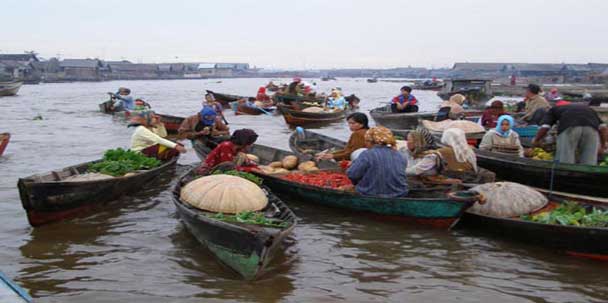Grenn Canyon Indonesian

Indonesia was also having Green Canyon itself is no less beautiful. Actually, this place has the real name is Cukang Taneuh. Green Canyon own name was popularized by a French citizen in 1993. While Cukang Taneuh got the sense that the land bridge. That's because over the valley and ravine Green Canyon there is a bridge of land used by farmers around there to get to their gardens.
Green Canyon Indonesia is located in the village of Kertayasa, District Cijulang, Ciamis, West Java. From City Ciamis itself is about 130 km or if from Pangandaran is approximately 31 km. Near there is attraction attractions and the Airport Nusawiru Batukaras.
This amazing attraction is actually a flow of the river Cijulang passing through the cave full of beauty and charm stalaktif stalakmitnya. In addition the area is also flanked by two hills, also with many rocks and grove of trees. Everything was formed as a natural painting is so unique and so challenging to discover.
To reach this location travelers must depart from the dock Ciseureuh. Then continue the trip by boat or paddle paste is widely available there. The distance between the dock with the Green Canyon site about 3km, which can be reached within 30-45 minutes. Along the way we will pass the river with green water tosca. Perhaps this is where the name of Green Canyon originated.
Once seen rafting with a narrow groove that difficult to pass by the boat means you've reached the mouth of Green Canyon, where the water is very clear bluish color. This is where the adventure of exploring the beauty of the initial attraction starts. From here tourists can go on up to the swimming or crawling on the edge of the stone. Supplied tires and floats for those who choose to swim. Despite having to go through this way, guaranteed to be completely secure way. Even for children 6 years and older is safe enough to flow down the river by using tires and guided by a chartered boat owners.
Travel will continue to be in the basin steep walls on either side of the river. The walls to present its own beauty, the unique shape resembles a cave whose roof has collapsed. Also in the top couple of times visitors will pass through the stalactites that are still energized water droplets land. After a few hundred meters of swimming, you will see some small waterfalls on the left and right are so captivating. If you continue to swim then visitors will come to the end of the road, where there are many caves inhabited by bats
The flow of the river is quite long, so that visitors can swim your heart's content while the flow of the waterfall. In addition to beautiful views over the water, Green Canyon will be a separate heaven for those who love diving. Staying bring some diving equipment, stunning scenery the notches in the water ready to be explored and enjoyed, complete with a variety of fish that swim to and fro in the bottom of the base. For those who like challenging adrenaline, can jump from a large stone with a height of 5m to the bottom of a deep base.
For those of you who really want to enjoy the beauty of the Green Canyon attraction should be familiar with the seasons. Because the best time to enjoy this attraction is keindahaan moments after entering the dry season. Because if the rainy season, it is feared torrential rivers and water colors will be brown.
Before you decide to go to the Green Canyon, you should first prepare enough cash. Because there tidakada bank or ATM. For ATM, where lodging and accommodation facilities are complete you can get in Pangandaran.
For access to boating, there is available a fleet of boats that quite a lot. There are about 100 boats that can take you to explore this attraction. On each boat will be equipped with an interpreter and task stones to guide you on your way.
Route that must be taken to get to the Green Canyon, namely: From Jakarta and TEM, You can follow the route directions to the Central Java through Tasik City-Ciamis Cities Banjar-Pangandaran. Of JAVA and JAVA MIDDLE EAST, For EAST JAVA you can go to the Direction Central Java first, then proceed to take the path to the West Java by following the path of Direction (Purworejo-Kebumen-Wangon-Banjar-Pangandaran-Ciamis).
For those of you who use public transport, of course, do not bother thinking about the route. Because the driver will take you directly to Pangandaran (Green Canyon). But to note that you Stay there, you can chose which are in hotels in Pangandaran many available or can also stay at the attraction Batukaras very close to Green Canyon. (For hotel information data you can see the list of the available hotels at this site).
Enjoy Vacation with Your Family Long, Visit and Enjoy Potential attractions Ciamis district to another, are no less interesting with the Green Canyon.














